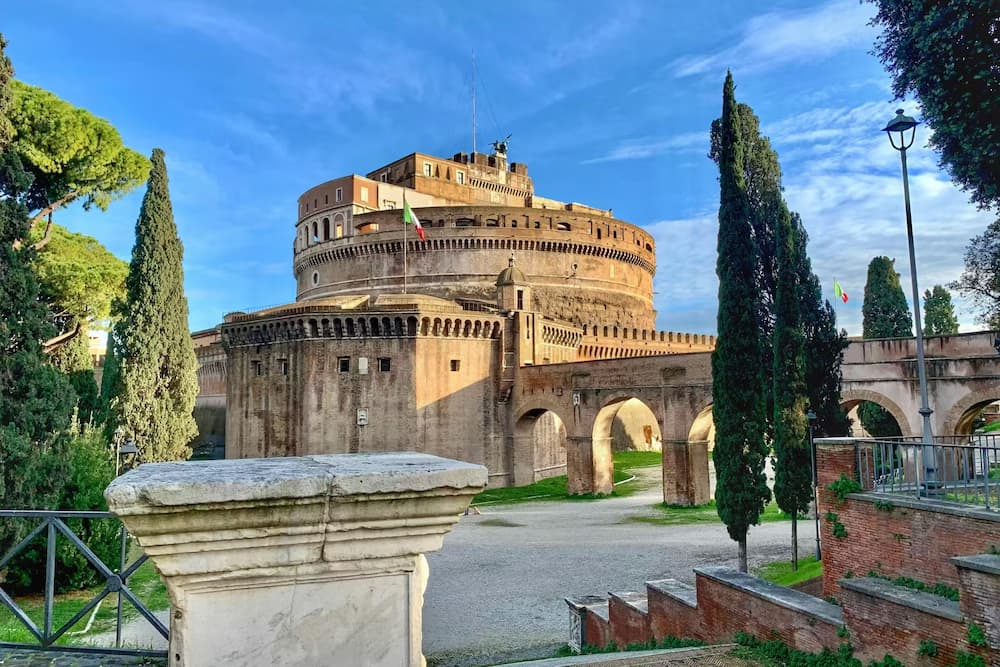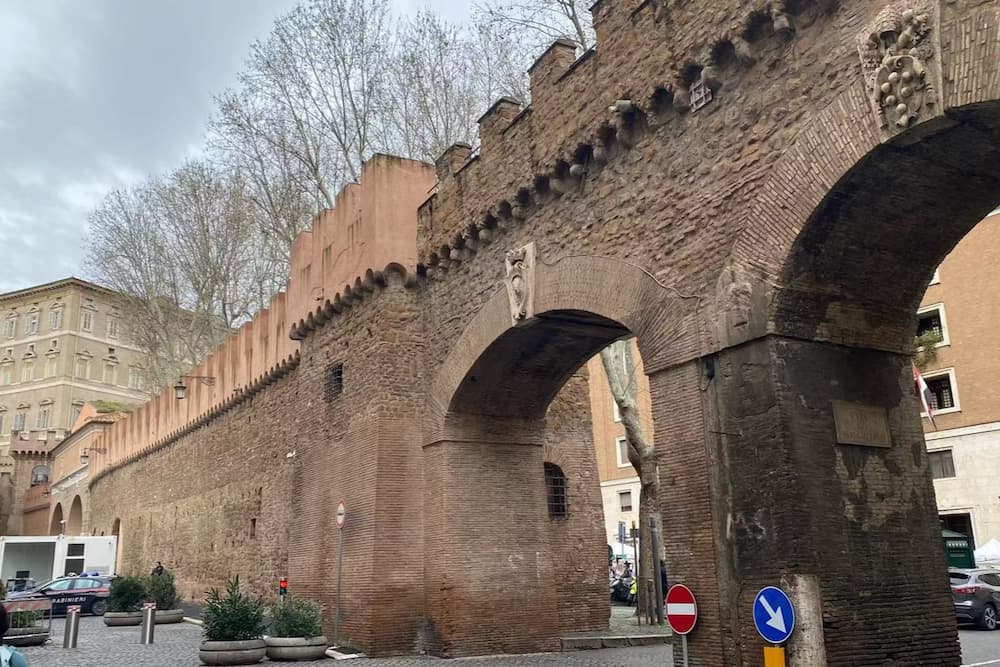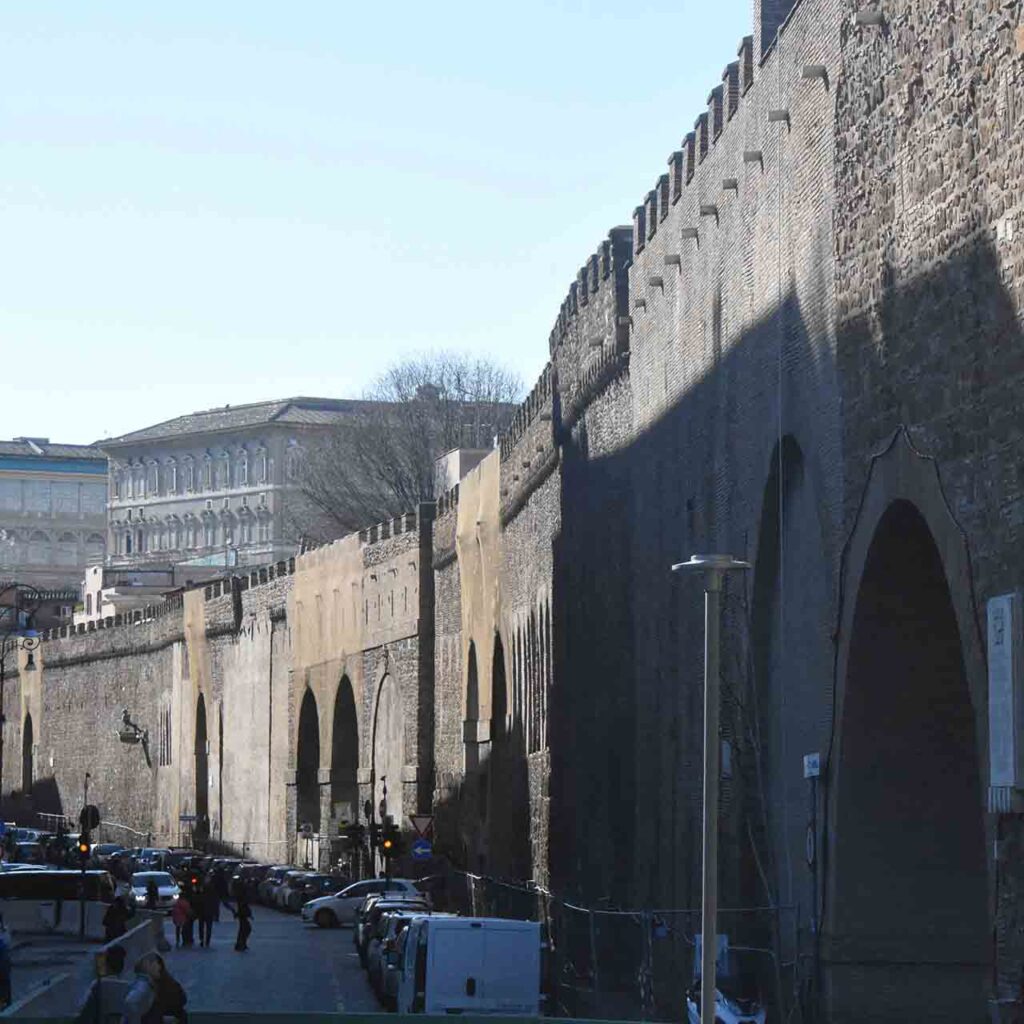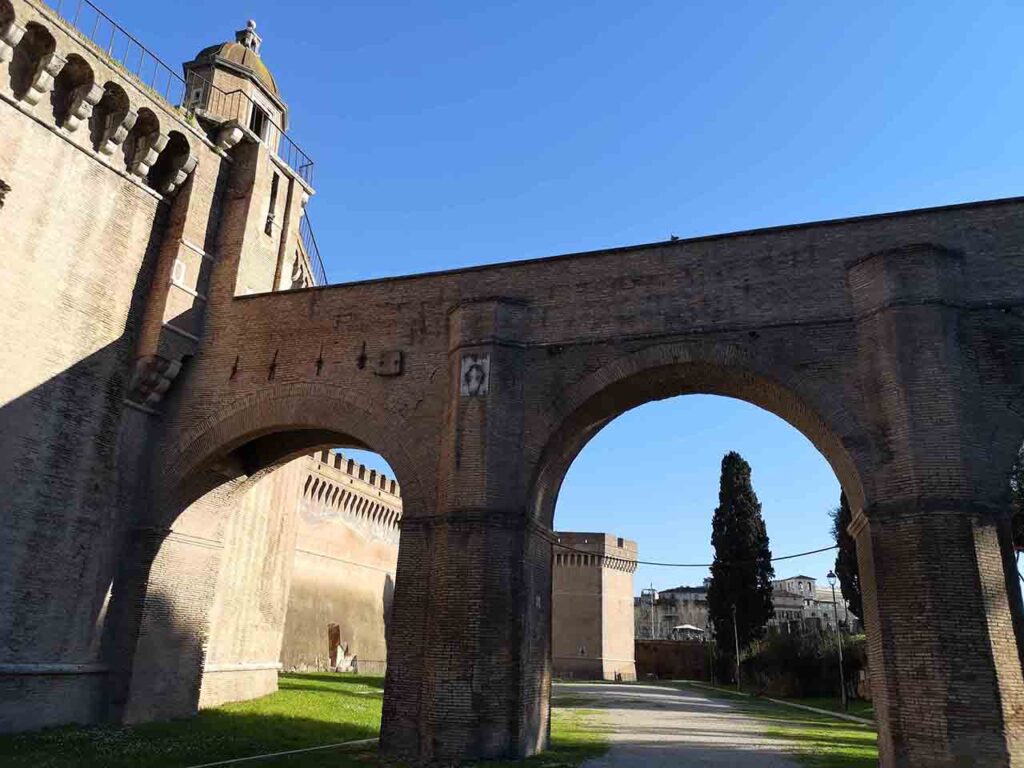The Passetto di Borgo is the fortified corridor about 800 meters long combining the Vatican a Castel Sant'Angelo. It was born for save the pope in times of crisis and, to this day, is a symbol of the link between the two poles of religious and military power in Rome.
The pontiffs actually walked it. Alexander VI in 1494 and Clement VII in 1527 used it to take refuge in the castle during invasions and sieges. Hence its fame as a papal escape route.
After centuries of oblivion, the Passetto is returned visitable with dedicated programs: from the December 23, 2024 visits resumed, now joined by daytime and evening slots, with entrance from the Mascherino Tower at Leonine City Square and exit at Castel Sant'Angelo. Also planned is a facilitated variant With redesigned elevators and slopes.
In the path you will see two levels: the upper walkway with views of St. Peter's and the city, and the covered corridor which holds the narrative of the Passetto as a secret road of the popes. At St. Mark's Bastion a room set up with objects and a multimedia installation awaits you.

The best-selling ever
Castel Sant'Angelo and Passetto di Borgo: Skip-the-line ticket
Purchase online and choose the time of your choice. Explore the Castel Sant'Angelo, the Ponte dell'Angelo, the prisons and the famous Passetto di Borgo in total autonomy.
Secure payment
Immediate confirmation
Cell phone ticket

Guided tour of Passetto di Borgo
Buy online and reserve your time. Discover the history of the Passetto di Borgo with an expert guide, exploring one of Rome's most fascinating places.
Secure payment
Immediate confirmation
Cell phone ticket
How to visit Passetto di Borgo
The Passetto di Borgo is accessible only by dedicated ticket and at specific times of the year.
You can choose it as a simple input combined with Castel Sant'Angelo, or have the full experience with a guided tour that reveals the history and secrets of the papal corridor.
The departure is always from the Piazza del Risorgimento, official meeting point for all visits.
Tickets for the Passetto di Borgo
Visit the Passetto di Borgo is a unique opportunity to discover one of the most secret and fascinating places in Rome.
This elevated corridor, which connects the Vatican to Castel Sant'Angelo, has seen historical passages of popes and dramatic moments in the eternal city.
Today you can access it with two types of tickets, which offer different experiences depending on your preferences.
Castel Sant'Angelo + Passetto di Borgo: Skip-the-line ticket

The best-selling ever
Castel Sant'Angelo and Passetto di Borgo: Skip-the-line ticket
Purchase online and choose the time of your choice. Explore the Castel Sant'Angelo, the Ponte dell'Angelo, the prisons and the famous Passetto di Borgo in total autonomy.
Secure payment
Immediate confirmation
Cell phone ticket
The first is the Castel Sant'Angelo + Passetto di Borgo skip-the-line ticket.
With this solution Access both the famous mausoleum of Emperor Hadrian, transformed over the centuries into a fortress and papal residence, both at the secret passage which connected the papal city to the Vatican.
Entry is quick and without waiting, with assistance at the meeting point in Risorgimento Square.
During the visit to the Passetto guidance is not provided, but you can still freely explore the route and admire the unique view of Rome.
It is the ideal choice if you want a flexible experience, with the possibility of discovering the two monuments independently.
Passetto di Borgo: Guided tour

Guided tour of Passetto di Borgo
Buy online and reserve your time. Discover the history of the Passetto di Borgo with an expert guide, exploring one of Rome's most fascinating places.
Secure payment
Immediate confirmation
Cell phone ticket
The second is the guided tour of the Passetto di Borgo.
In this case, in addition to skip-tail access, you will have an experienced guide who will accompany you along the papal corridor, telling you the story of the pontiffs who found refuge there in the most dangerous times.
Thanks to the headphones you will be able to clearly follow every explanation and uncover hidden details that might otherwise slip through the cracks.
Also here the meeting point is in the Piazza del Risorgimento, but it is necessary to arrive a little early.
This ticket is designed for those who wish to living the experience in a more immersive way and get a complete historical picture of this legendary passage.
Accessibility and useful tips

The Passetto di Borgo can also be visited with a facilitated route designed for those who Can't or won't use the stairs.
You enter from the Mascherino Tower. Access involves a 90 cm wide door and a short stretch about 85 cm wide with 90° bend towards theelevator.
The platform has entrance 80 cm e 120×125 cm booth and connects, in just over 1 minute, to the exterior walkway with a view of St. Peter's.
From the walkway we proceed towards Castel Sant'Angelo for about 450 meters. The pavement is donkey-backed and may submit slight slopes For water runoff.
A second elevator (entrance 80 cm, cabin 110×140 cm, ~35 seconds) leads to the covered corridor for the return towards the Vatican.
Here the width varies from 215 cm a 75 cm (media 83/85 cm), minimum height 240 cm e loopholes That guarantee light and air. È not recommended to those suffering from claustrophobia.
The distance in the corridor is of others 450 meters. You leave the Mascherino Tower Using the same elevator.
The capacity Of the facilitated route is 20 participants, with maximum 5 wheelchairs per shift. For manual wheelchair is mandatory a escort, free of charge. The track does not include the Bastion San Marco; hence the rate is reduced compared with ordinary visits.
In case of adverse weather the route may undergo variations without compromising fruition. The entire reopening project introduced accessible solutions Along the Passetto.
Be sure to wear appropriate footwear and bring water In the warm months.
If you suffer the tight spaces, evaluate the visit outdoor daytime or the evening With breaks in the ramparts.
If you travel with strollers o bulky aids, first check the useful measures Of the route.
If you would like more information instead, read our page on the Castel Sant'Angelo tickets.
Where it is located and how to get to the Passetto di Borgo
For locate the Passetto di Borgo you don't need a map: you just need to know where to look.
Just behind the Bernini colonnade, facing towards St. Peter's Square and look for Porta San Pellegrino.
Today it is known as Gate of the Swiss because it gives access to the barracks of the Swiss Guard. Under a small window still read the coat of arms of Alexander VI And the 1492 inscription.
It is the "Vatican" graft of Passetto, largely hidden by the columns.
Move to Largo del Colonnato.
Here the fortified corridor crosses the roadway with two large fornices: the left one opened by Pius IV in 1562 to connect the old and the new Borgo e the other realized by the Municipality of Rome in 1933. They are the most obvious sign of the coexistence of medieval layout and modern urbanism.
Now follow with your gaze via dei Corridori e via di Borgo Sant'Angelo. Above the facades you recognize the elevated walkway with battlements and small openings: this is the profile of the Passetto, about 800 meters long, which runs parallel to the streets up to the Castle.
Arriving in the area of the Mole Adriana Gardens (Hadrian's Park), look at the last eight arches which they climb over the moat and the green before entering the St. Mark's Bastion of Castel Sant'Angelo. It is one of the most photogenic features from the outside, clearly visible while walking in the park or from the Lungotevere Castello.
Photo tip: The sunset lights enhance the upper walkway with the dome of St. Peter's in the background; in the early morning, however, the fornices of Largo del Colonnato are best read without traffic. For a change of perspective, try from the terrace of Castel Sant'Angelo: from here the Passetto can be seen in full.

The best-selling ever
Castel Sant'Angelo and Passetto di Borgo: Skip-the-line ticket
Purchase online and choose the time of your choice. Explore the Castel Sant'Angelo, the Ponte dell'Angelo, the prisons and the famous Passetto di Borgo in total autonomy.
Secure payment
Immediate confirmation
Cell phone ticket
The history of Passetto di Borgo

Medieval origins and reasons for the Passetto
The Passetto di Borgo arises out of a specific need: save the pope by securely connecting Vatican e Castel Sant'Angelo. It is a fortified corridor about 800 meters long, the largest remaining stretch of the Leonine Walls. It runs from the Apostolic Palace at St. Mark's Bastion of the castle, overlooking via dei Corridori e via di Borgo Sant'Angelo.
His roots sink into a defensive system that, according to the sources, exploited pre-existing structures from the late antique and early medieval periods. In 9th century Leo IV fortifies the area with the enclosure of the Leonine Walls to protect the Civitas Leonina. This route will then be reused for the connection to the Mole Adriana.
The formalization of the Passetto is generally attributed to Nicholas III at 1277, when deriving an elevated path on the edge of the Vatican Walls. Part of the historiography, however, recalls a later construction site, between Boniface IX and theantipope John XXIII, with later additions. In the fifteenth and early sixteenth centuries intervened Nicholas V, Sixtus IV e Alexander VI, which add patrol walkways, battlements e elevations.
The function is twofold. On the one hand, guaranteeing the pontiff a escape safe to the Castle in case of siege or turmoil. On the other, check the Borgo from above and secretly manage prisoner transfers towards the prisons of Castel Sant'Angelo. Two episodes fix the collective memory: Alexander VI in 1494 and Clement VII in 1527, during the Sack of Rome.
Renaissance
In Four hundred the Passetto di Borgo changes gears. The popes turn it into a modern military device: Nicholas V initiates an extensive worksite on the Vatican Walls and also boosts the defenses of Castel Sant'Angelo with new ramparts grafting onto the Passetto route. The goal is clear: Make the connection faster and safer with the Castle and improve the control of the Village from above.
Among 1471 e 1484 Sixtus IV work continues, while at the beginning Five hundred Alexander VI Borgia launches a massive strengthening: you add patrol walkways, battlements, watchtowers, elevations and a tract covered which gives the Passetto much of its current appearance. These are the years when the corridor really operates as a defensive backbone Between Vatican and Castle.
In parallel, the Castle is also being updated: the ramparts as the St. Mark's Bastion are reorganized for theartillery, creating a close dialogue with the Passetto. The connection remains active along the March patrol, ready to channel men and orders in case of crisis. It is the full operational golden age Of the corridor.
Great escapes and historical memory
The myth of the Passetto di Borgo arises from two episodes that set the standard.
In 1494 Alexander VI Borgia crosses the corridor to take refuge in Castel Sant'Angelo during the invasion of Charles VIII of France. It is proof that the Passetto functions as popes' escape route.
In 1527, during the Sack of Rome, Clement VII walks along the Passetto again to save himself from the onslaught of the lanzichenecks by Charles V. La Swiss Guard covers the retreat and is decimated on the Vatican front. Even today, along the route, one can see blunderbuss marks imprinted on the walls. These wounds tell better than any chronicle the function of the corridor as a strategic lifesaver Between Vatican and Castle.
Since then, the image of the Passetto remains linked to the formula that you also find in official visits: "the popes' escape route". It is a label born of facts and now directs the museum and tourist narrative of the route.
From the seventeenth century to the present
With the end of the Five hundred the Passetto di Borgo gradually loses its centrality military. The neighborhood changes, defensive needs wane, and the fortified corridor becomes more and more part of the urban fabric. Already in the 1565 the new walls of Borgo Pio, Borgo Vittorio and Borgo Angelico mark the transition from bulwark to an integrated element in the city.
In Six hundred e Eighteenth century more action is taken on the road layout than on the strategic function. Pius IV opens up new fornices to connect the old and new Borgo, while other crossings will be made in contemporary times by the Municipality of Rome. The Passetto remains at high elevation, but its profile coexists with neighborhood streets, houses, and services.
Among Nineteenth century e Twentieth Century the corridor remains closed or visited only on special occasions. Its fame is more historical than practical, linked to the great papal escapes and the memory of the Borgo. With the Jubilee 2000 the Passetto comes recommissioned for dedicated routes, marking the first real reopening in recent times.
After new interventions of securing and restoration, the December 23, 2024 comes the regular reopening to the public. The operation is curated by the Special Superintendence of Rome with the Museum Directorate and thePantheon Institute and Castel Sant'Angelo, which also set a new museological narrative. Today's route is more accessible because of two elevators and to the reconfiguration of slopes, as well as an updated set-up to the St. Mark's Bastion with objects and multimedia installation.
Today the Passetto can be visited with permanent programs e guided tours. Daytime and evening slots, theentrance from the Mascherino Tower at Leonine City Square and the output at Castel Sant'Angelo make the experience linear and well-organized.
Structure and architecture

Urban layout
The Passetto di Borgo runs behind Bernini's colonnade, skirts via dei Corridori e via di Borgo Sant'Angelo and is grafted into the St. Mark's Bastion by Castel Sant'Angelo. It is a elevated corridor about 800 meters long: the historical connection between Vatican e Castle running through the ward Village.
Today you enter from the Mascherino Tower, in Leonine City Square. Here you will find a gateway which leads, with a short bend, to the elevating platform for the start of the tour. This is the official entrance to the permanently active guided tours from the December 23, 2024.
Along the route, at the height of St. Peter's Square, you recognize the ancient Porta San Pellegrino (today also Gate of the Swiss), almost obscured by the colonnade. At the top one can still see the coat of arms of Alexander VI: a key reference to orient you to the place.
Immediately afterwards, at Largo del Colonnato, scroll the fornices that relate the old and new Borgo: the left one wanted by Pius IV in 1562 e The one opened by the City of Rome in 1933. Further on, other gateways created between the sixteenth and twentieth centuries dot the route (via del Mascherino, Farinone alley, alley of the Balls, Orpheus Alley, via Porta Castello). The last eight arches climb over the moat and the gardens of Hadrian's Park Before arrival at the Castle.
The itinerary ends at the St. Mark's Bastion, where today you are welcomed by a set-up environment with works and objects related to the history of the corridor and amultimedia installation That closes the visit.
Levels, walkways and battlements
The Passetto di Borgo is a fortified corridor on two levels.
At the top is the uncovered walkway: served the guards for the patrol and today gives views of St. Peter's and Rome. Below runs the covered corridor, the most "secret" part, designed to moving the pope safely from Apostolic Palace a Castel Sant'Angelo.
The structure takes advantage of the Vatican Walls and enhances its share with elevations historical. Over time popes such as Nicholas V, Sixtus IV e Alexander VI add patrol walkways, battlements e watchtowers. This is the aspect military you still recognize today along the corridor profile.
The higher path is punctuated by blackbirds e openings overlooking the Village: they were used for supervise and, if necessary, for strike from above In case of riots. The lower floor is more tight and protected, without outward exposure, ideal for the reserved passages and for the transfer of excellent prisoners Toward the Castle Prisons.
Toward Castel Sant'Angelo the Passetto will grafts into the Bastion San Marco, part of the renaissance ramparts appropriate to theartillery. Here today you will find a set-up environment with objects and amultimedia installation that tell the story and functions of the corridor.
In the modern path you come back to perceive this double nature: surveillance at height e protected transit. The layout of the tours also enhances the two floors, alternating outdoor sections e tracts covered along the about 800 meters separating Vatican and Castle.
Architectural nodes and notable points
The path of the Passetto di Borgo is dotted with nodes that tell centuries of history. If you know them, the visit changes pace.
Immediately next to the colonnade, look for Porta San Pellegrino. It is the Gate of the Swiss, today access of the Swiss Guard. Prominent here are the coat of arms of Alexander VI and the Latin inscription of the 1492: a detail that brings you into the Borgian season before you even take a step. The door is almost hidden by the columns, but once you spot it, you never forget it.
A Largo del Colonnato the Passetto bypasses the road system with two fornices opened in eras far apart: on the left the one wanted by Pius IV at 1562 To connect the old and the new Village, then the gap created by the Municipality of Rome at 1933. Along the route, other sixteenth-century fornices appear on via del Mascherino, Farinone alley, alley of the Balls, Orpheus Alley e via Porta Castello; some will be doubled only in the Twentieth Century. Even the small Marian shrines under the arches tell the devotion of the neighborhood.
Continuing towards the Tiber, the last eight arches exceed the moat and the gardens of Hadrian's Park, anticipating the arrival at Castel Sant'Angelo. It is one of the most photogenic features of the corridor, where architecture dialogues with the historic greenery of the park.
On the curtains, especially toward the Vatican, look for the blunderbuss marks: are the scars of the Sack of Rome in 1527, when the lanzichenecks stormed the area and Clement VII took refuge in the castle. These holes are concrete evidence of the function defensive Of the Passetto.
The corridor plugs into the St. Mark's Bastion, the heart of integration with the Renaissance defenses of the Castle. Here you recognize the helical ramp which connects to the March patrol, the gunboats and service rooms. Today the bastion houses a staging with objects and a multimedia installation That closes the visit.
On the Vatican side, the operational point of the visit is the Mascherino Tower at Leonine City Square. It is your entrance to the contemporary pathway: from here you access the two levels, covered e discovered, alternating historical narrative and views on St. Peter's and the city.
From upper walkway facing towards the dome of St. Peter's: is one of the iconic shots of the Passetto, especially at sunset.
The Passetto in the defensive machine of the Castle
The Passetto di Borgo Is not just a "secret" corridor. It is an integral part of the defense of Castel Sant'Angelo. The track will grafts into the Bastion San Marco, where the renaissance ramparts convoys men, orders and ammunition to the Castle's walkways. Here the Passetto became a multiplier of command and control On the Borgo and the Tiber.
At St. Mark's Bastion recognize key elements of military architecture: the helical ramp which connects at altitude the march patrol e sixteen gunboats carved out of the interior. The arrangement originated in the age of Nicholas V, is enhanced with Alexander VI, then high by Pius IV right up to the patrol march. In age Barberini fits theheavy artillery. The connection with the Passetto Is still active in the museum itinerary.
This integration explains the effectiveness of the corridor in a crisis: from walking covered one would safely enter the Castle device, while from the level discovered the neighborhood was controlled, manned the fornices and managed themselves reserved transfers towards the prisons. The "hybrid" function between popes' escape route e defensive backbone is attested by historiography and reiterated in the account of the visit.
Today this structural report you experience it firsthand: visits include the St. Mark's Bastion and, in some evening formats, the walk on the ramparts, passing through the Urn Hall, the helical ramp and the dromos with the museum closed. This is the best way to understand how the Passetto "dialogues" with the war machine Of the Castle.

The best-selling ever
Castel Sant'Angelo and Passetto di Borgo: Skip-the-line ticket
Purchase online and choose the time of your choice. Explore the Castel Sant'Angelo, the Ponte dell'Angelo, the prisons and the famous Passetto di Borgo in total autonomy.
Secure payment
Immediate confirmation
Cell phone ticket
What can be seen along the route today

The visit of the Passetto di Borgo makes you go through two levels. Above is the uncovered walkway with spectacular views of St. Peter's and Rome. Below runs the covered corridor, the most "secret" soul of the route, designed to moving the pope safely until Castel Sant'Angelo. The track starts from the Mascherino Tower and comes to the St. Mark's Bastion.
Along the way you recognize battlements, patrol walkways and various openings on the ward Village. In some places you can still distinguish the blunderbuss marks of 1527, memory of the Sack of Rome. These are details that tell, by themselves, the defensive function of the corridor.
Upon arrival, the St. Mark's Bastion welcomes a set-up environment with works and objects dedicated to the history of the Passetto and the Castle. Here you will also find a multimedia installation by Azure Studio, designed to condense episodes, characters and transformations of the corridor. It is the natural closure of the visit, between narrative and archaeology of architecture.
Curiosities, myths and pop culture
In Rome they call it "er Corridore". It is an affectionate nickname for the Passetto di Borgo, the elevated corridor about 800 meters long uniting Vatican and Castel Sant'Angelo. The nickname also recurs in more recent sources and is perfect for rendering the idea of its continuous course above the houses of the Village.
The most frequently told legend is that of the "77 times". It is said that, walking back and forth along the Passetto to 77 steps, you can regain lost virility. The myth stems from the licentious aura attributed to Alexander VI Borgia, who would often use the corridor to reach private meetings. Today he is treated as folkloric anecdote, but it remains one of the most beloved curiosities among Romans.
The Passetto also entered the pop culture.
In the book Angels & Demons by Dan Brown and in its film adaptation of the 2009 directed by Ron Howard, the secret connection between the Vatican and Castel Sant'Angelo plays a recognizable role in the final race of the protagonists.
Several guides to the film locations explicitly report the Passetto di Borgo As a symbolic stop on the itinerary.
Looking for more info on visiting the Passetto di Borgo? Check out our page with the timetables of Castel Sant'Angelo.
FAQ on the Passetto di Borgo in Castel Sant'Angelo
The Passetto di Borgo is the fortified corridor linking Vatican e Castel Sant'Angelo. It is long about 800 meters and is partly elevated over the Vatican Walls.
L'entrance is at the Mascherino Tower at Leonine City Square while theexit is at Castel Sant'Angelo. Introduce yourself 15 minutes before Of the booked time.
No, the visit is scheduled timetable. You can book your admission from here.
Online or via call center at 0639967100. Availabilities open in stages.
Want to make a reservation? Click here
There are two main formats, with durations from 15-30 minutes up to about 1 hour. Rates vary depending on the format and whether admission to Castel Sant'Angelo is included.
Normally no: the Passetto requires a dedicated reservation. In some special evenings access to the upper level can be included in the Castle's evening ticket. Always check the official calendar.
Yes, the visit with facilitated route provides elevators and adapted track, with capacity 20 people e max 5 wheelchairs. Useful measurements: door 90 cm, stretch 85 cm, elevators 80 cm of access, cabins 120×125 cm e 110×140 cm. È not recommended to those suffering from claustrophobia.
Italian e English, with dedicated slots.
Yes. La evening visit matches the Passetto to a walk on the ramparts of the Castle when the museum is closed, passing through Urn Hall, helical ramp e dromos.
Walk two levels: uncovered walkway with views of St. Peter's e covered corridor, with arrival at the St. Mark's Bastion where you find a staging and amultimedia installation.
Access is only with visit o silent companion booked; it is not a "free" route.
Yes. Beware, however, of stairs, tight spaces in the covered section and capacities contingent; choose if you prefer daytime o facilitated

The best-selling ever
Castel Sant'Angelo and Passetto di Borgo: Skip-the-line ticket
Purchase online and choose the time of your choice. Explore the Castel Sant'Angelo, the Ponte dell'Angelo, the prisons and the famous Passetto di Borgo in total autonomy.
Secure payment
Immediate confirmation
Cell phone ticket